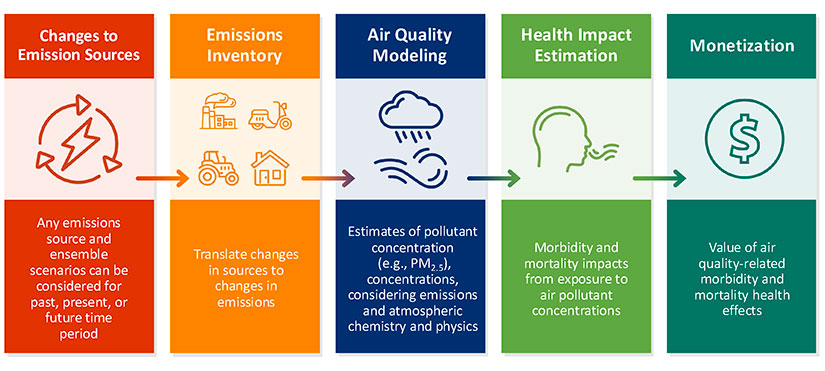Air Quality
NREL's air quality research investigates the energy system’s impact on air quality, public health, and renewable energy generation, as well as the distribution of those impacts.

Improving Public Health and Sustainability by Addressing Air Quality Problems
Outdoor air pollution contributes to over four million deaths per year, making it the fourth leading cause of death globally. As governments and public leaders work to mitigate these effects, they rely on an accurate understanding of air quality and its impact on health to evaluate the effectiveness of potential actions and interventions.
NREL researchers have developed the capabilities needed to provide these insights both domestically and internationally. NREL's air quality research capabilities include:
- Codevelopment and implementation of a novel, reduced-complexity air quality model, Global Intervention Model for Air Pollution (Global InMAP), to model global air quality and health changes
- Application of a range of source-specific and regional air quality models to analyze changes to pollutant concentrations
- Air quality and public health impact analysis for both domestic and international regions, including on jobs and economy
- Quantification of air quality and public health cobenefits for any energy sector’s clean transition.
These capabilities allow NREL to conduct air quality research in diverse contexts, including both domestic and international, all energy sectors including power, transportation and industry, and fuels such as hydrogen and biofuels. These analyses are often considered together with accounting of greenhouse gas emissions, both direct and life cycle emissions. In each of these analyses, NREL researchers follow a fundamental multistep approach by:
- Identifying emission sources and their changes
- Translating the changes in sources to changes in emissions
- Modeling air pollutant concentrations
- Conducting health impact estimations
- Analyzing the distribution of pollutants and health impacts to regions and populations.
These steps are applied both domestically and internationally to develop a comprehensive understanding of a given region's air quality status and help map a path toward improvements.

Analysis Areas
Conventional power generation technologies based on fossil fuels are a significant source of greenhouse gas emissions (GHG) as well as non-GHG air pollutants. As more stakeholders consider and incorporate clean energy technologies to meet U.S. electricity demand, NREL air quality researchers are investigating the impact of the transition on air quality and public health as well as as distributional impacts (e.g., by income). Through the modeling of various future energy scenarios, researchers are able to determine which future clean energy pathways lead to the greatest reduction of pollutant emissions and consequent air quality-related health problems. This includes (but is not limited to) conversion of natural gas-burning turbines to combustion of hydrogen, both in blends with natural gas and as pure hydrogen. It also includes robust analysis of changes to generation technology operations which can lead to higher or lower emissions, e.g., increased cycling of combustion units as more variable renewables are integrated. A final example is our research into the cocapture of non-CO2 pollutants in carbon capture systems integrated onto coal or natural gas plants.
This analysis capability has been integrated in several large-scale, high-impact future scenario studies, including Los Angeles 100% Renewable Energy Study, and a report addressing additional environmental considerations of the U.S. Department of Energy's Solar Futures Study, where researchers quantified the air-quality benefits of increasing solar deployment while also increasing electricity demand through electrification of vehicles.
Publications
Air Quality and Public Health Cobenefits of 100% Renewable Electricity Adoption and Electrification Pathways in Los Angeles, Environmental Research Letters (2024)
Environmental and Circular Economy Implications of Solar Energy in a Decarbonized U.S. Grid, NREL Technical Report (2022)
Chapter 9: Air Quality and Public Health in the Los Angeles 100% Renewable Energy Study, NREL Technical Report (2021)
On the Path to SunShot: The Environmental and Public Health Benefits of Achieving High Solar Penetrations in the United States, NREL Technical Report (2016)
NREL applies its air quality research capabilities internationally to help motivate a just energy transition around the world. Recent air quality research into South and Central Asia examined connections between electricity production and air quality. Researchers focused on identifying electricity-sector policies that can mitigate the impact of fossil-fuel power generation on air quality and public health, and measure the impact of air pollution on solar power generation.
In order to expand international air quality research capabilities, NREL supported the development of the Global InMAP, in partnership with the University of Minnesota and the U.S. Department of State. This model expands on a previous open-source model to estimate air pollution outcomes and the impact on health damages around the world. Global InMAP can model air quality and health changes for any type of source at global, regional, national, and subnational scales. It is the first global air quality model that is designed for ease of use by stakeholders to apply findings to public health and distributional analyses, development strategies, and policy formulation. In turn, it empowers stakeholders to make data-driven decisions about clean energy deployment. Its first application was to evaluate renewable energy integration and transmission scenarios in Southeast Asia, with more applications underway.
Using the Global InMAP, researchers can:
- Quantify air quality and health benefits of changes to any air pollutant-emitting source, being especially well-suited for prospective scenarios
- Provide baseline air quality assessment to inform planning, policymaking, and regulatory decision-making
- Assist in the prioritization of mitigation strategies or sources to target, for instance, within the context of decarbonization strategies and pathways
- Help regional partners communicate air quality cobenefits to stakeholders.
Examples include:
- Power sector transitions to incorporate more clean energy sources, (e.g., reducing use of coal or adding carbon capture and sequestration to coal plants, transitioning natural gas plants to hydrogen, or increasing shares of solar or wind)
- Electrification of certain types of vehicles and their air quality, health, and just energy transition benefits
- Comparison of strategies to achieve reductions in greenhouse gas emissions in different sectors
- Comparison of the benefits of electrifying vehicles in certain locations (e.g., buses in certain zones in a city) or of electrifying other vehicles categories (e.g., buses compared to heavy-duty trucks, or taxis compared to two-wheeled vehicles).
Publications
Quantifying Impacts of Renewable Electricity Deployment on Air Quality and Human Health in South Asia Based on AIMS III Scenarios, NREL Fact Sheet (2022)
Quantifying Impacts of Renewable Electricity Deployment on Air Quality and Human Health in South Asia Based on AIMS III Scenarios, NREL Technical Report (2022)
An Overview of Policies Influencing Air Pollution From the Electricity Sector in Central Asia, NREL Technical Report (2022)
An Overview of Policies Influencing Air Pollution From the Electricity Sector in South Asia, NREL Technical Report (2021)
The processes involved in growing biomass feedstocks and producing biofuels result in the emissions of a wide range of air pollutants. To better understand this important source of air pollution, NREL air quality researchers study air pollutant emissions from the entire biofuel supply chain and their implications on air quality and human health. Additionally, NREL studies how air quality regulations can affect the cost, operation, and sustainability of the biofuels industry, generally, and biorefineries, specifically.
NREL's work focuses on two important stages of the biofuel life cycle—biomass production, harvest, and transport and biomass conversion to biofuels in biorefineries—for two purposes: to assist industry and regulators in accurately quantifying emissions for permitting and other reasons, as well as to anticipate potential air quality and health implications of deployment of agricultural and industrial biofuels-related systems.
To investigate the two stages, NREL develops and applies air pollutant emissions quantification tools and uses county-level data to quantify air pollutant emissions. For feedstock production, we use our open-source Feedstock Emissions to Air Model. For biorefineries and other industrial infrastructure, NREL uses the U.S. Environmental Protection Agency's guidance documents and models, a material balance approach, and permits for analogous units to develop emission estimates and understand permitting implications for the industry of the future.
These independently developed estimates help the industry create more accurate and trusted air permit applications, and likewise help regulators in their review of air permits. Existing and prior collaborations in this area have helped several partners, including NYSERDA, ExxonMobil, and Clean Fuels Alliance America.
Recently, NREL’s research has focused on sustainable aviation fuel (SAF) as the biofuel product with potential to improve the sustainability performance of the aviation industry, as prioritized by the U.S. Department of Energy. Our analysis has focused on understanding the environmental implications of the SAF industry from different perspectives: electrofuels (CO2-to-SAF) production as part of the CO2-to-Fuels Consortium; emissions and air quality impacts of existing ASTM-approved pathways; and air quality modeling and analysis to quantify the public health benefits from potential adoption of SAF at different airports around the United States.
Learn more about NREL's biofuels air emissions analysis research.
Publications
Biochemical Conversion of Herbaceous Biomass to Renewable Diesel: Net Greenhouse Gas and Air Pollutant Trade-offs, American Chemical Society ES&T Air (2025)
Sustainable Aviation Fuel (SAF) State-of-Industry Report: State of SAF Production Process, NREL Technical Report (2024)
Sustainable Aviation Fuel State-of-Industry Report: Hydroprocessed Esters and Fatty Acids Pathway, NREL Technical Report (2024)
Emission Factors of Industrial Boilers Burning Biomass-Derived Fuels, Journal of the Air and Waste Management Association (2023)
Biorefinery Upgrading of Herbaceous Biomass to Renewable Hydrocarbon Fuels, Part 2: Air Pollutant Emissions and Permitting Implications, Journal of Cleaner Production (2022)
Characterization Factors and Other Air Quality Impact Metrics: Case Study for PM2.5-Emitting Area Sources From Biofuel Feedstock Supply, Science of the Total Environment (2022)
Bio-Oil Coprocessing Can Substantially Contribute to Renewable Fuel Production Potential and Meet Air Quality Standards, Applied Energy (2020)
Potential Air Pollutant Emissions and Permitting Classifications for Two Biorefinery Process Designs in the United States, Environment Science and Technology (2017)
Federal Air Pollutant Emission Regulations and Preliminary Estimates of Potential-to-Emit From Biorefineries. Pathway #2: Conversion of Lignocellulosic Biomass to Hydrocarbon Fuels Fast Pyrolysis and Hydrotreating Bio-Oil Pathway, NREL Technical Report (2017)
Economic Implications of Incorporating Emission Controls to Mitigate Air Pollutants Emitted From a Modeled Hydrocarbon-Fuel Bio Refinery in the United States, Biofuels, Bioproducts, and Biorefining (2016)
Energy and Atmospheric Systems Catalyzer and Other Cross-Cutting Research Areas
NREL launched the Energy and Atmospheric Systems Catalyzer to investigate the multidirectional relationships across climate, air quality, and energy systems. This catalyzer is focused on identifying emerging questions, establishing new research capabilities, and providing thought leadership in climate change and atmospheric sciences. The catalyzer's concentrated efforts have enabled broader use of emissions and air quality models in flagship studies and have expanded air quality analysis capabilities for future domestic and international partnerships.
One example analysis of the cross-cutting linkage between atmospheric systems and energy regards the impact of aerosols on solar resources. The impact of next generation satellite retrievals that provide finer resolution aerosol measurements and advanced processing can improve our understanding of the spatial variability of solar resources, leading to better investments.
Resiliency of future energy systems to catastrophic natural disasters such as wildfires, requires systematic analysis of the impacts such events could have on the complex and interconnected power grid. NREL recently completed novel analysis on this topic, including quantifying wildfire impact on changes to solar generation with subsequent implications for power reserve planning and energy prices.
Publications
Impact of Wildfires on Solar Generation, Reserves, and Energy Prices, NREL Technical Report (2023)
Improvement of Aerosol Optical Depth Data for Localized Solar Resource Assessment, Solar Energy (2023)
Partner With NREL
NREL works with stakeholders at the international, domestic, and regional levels to analyze the impacts of energy system changes on air quality and public health.
Learn how to partner with NREL.
Contact
Share

